Switch Offers the World’s Only Tier 5® Platinum Data Centers
Switch invented the Tier 5® Platinum standard because Switch data center designs, facilities and operations far surpass the highest data center benchmarks available. Switch’s CEO and Founder, Rob Roy has continued designing, building and operating data centers since 2000. Rob Roy has well over 700 issued and pending patent claims that protect his vision and inventions. Accordingly, for nearly two decades, Switch’s data center and telecommunication technology and services have been praised as Tier Elite® – above and beyond any current tier metric.
As demonstrated by the foils below, in 2014, Switch became the first and only carrier-neutral multi-tenant/colocation facility to be certified “Tier IV Gold” by the Uptime Institute. In 2016, Switch became the only entity to do so – for a second time. For each facility, Switch obtained certification in both Design and Facility categories. Switch then underwent a rigorous analysis of its operational teams and was awarded “Tier IV Gold” certifications for Operational Excellence® by the Uptime Institute.
Switch pursued industry certifications to provide clarity to those less familiar with data center technology. Switch also wanted to ensure no one was misled by less-than-truthful competitors misrepresenting the quality or reliability of their facilities. To continue its pursuit of building the world’s best data centers, Switch raised the bar beyond current industry standards with its Tier 5 Platinum data center standards.
Tier IV vs. Tier 5®
Switch obtained the Uptime Institute Tier IV Gold certifications in 2014 and 2016. Since that time, Switch became concerned that other data center standards fail to provide sufficient transparency or accountability. Thus, Switch identified additional elements it has practiced for years that are central to mission-critical reliability in the increasingly dynamic data center ecosystem needs of today.
Tier 5 Platinum not only encompasses the resiliency and redundancy in other data center ratings systems, but also evaluates more than 30 additional key elements, such as long-term power system capabilities, the number of available carriers, zero roof penetrations, the location of cooling system lines in or above the data center, physical and network security and 100-percent use of renewable energy.
“The original data center standards were created for legacy data centers in the early 1990s,” said Samuel Castor, who helped formalize Switch’s new Tier 5 standards in partnership with Switch’s engineers and under the direction of Rob Roy. “The spectrum of data center options has greatly expanded since their creation. Customers can now choose between a broad array of options, from in-house, to carrier, to colocation, cloud or managed service offerings. The common core of each of these offerings needs to be much more than just power and cooling. The underlying infrastructure must contemplate security, connectivity, sustainability, optionality and independence. To be helpful and relevant, our industry standards must be expanded as well.”
Industry experts and users alike understand that major threats to data center uptime include water damage, reliance on too few telecommunication carriers, being located in a high-risk geo zone, and inadequate physical and network security. These mission-critical elements are not being evaluated in other data center rating systems. Switch believes this lack of transparency and holistic relevance makes it difficult for CTOs, CIOs and data center managers to understand the deep dive differences between colocation product offerings when selecting a provider. Switch introduced the Tier 5 standard in an effort to reduce the lack of transparency and enhance the reliability of data center rating standards.
Castor continued: “A tidal wave of technological change has been cresting. When the original data center standards were developed by Hank Seader and Ken Brille back in the early days, no one envisioned the world would evolve as much as it has. It is now more critical than ever for customers to have transparency into the sustainability and reliability of their data center service providers. Switch’s Tier 5 standard focuses on improving the transparency and accountability of such an important and mission-critical part of all of our daily lives, the infrastructure that supports the Internet of Absolutely Everything.”
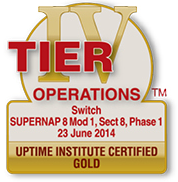
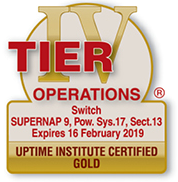
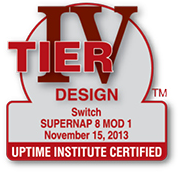
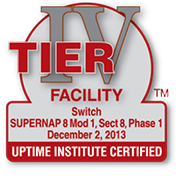
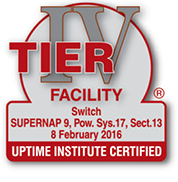
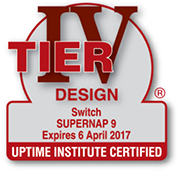
Switch’s Tier 5 Platinum guarantees that a data center’s power and cooling systems are fault sustainable, but also guarantees many other elements critical to support the Internet of Absolutely Everything®. Switch’s Tier 5 Platinum contemplates internet connectivity and reliability of carrier services, physical security, regional disaster risks, and the sustainability and energy efficiency of a facility.
A detailed comparison between the Tier IV standard and Switch’s Tier 5 standard is available here.
Continued Excellence: Data Center Standards Foundation
Beyond the Tier 5 Platinum standard, Switch sees the need for industry alignment and self-regulation. To that end, Switch has worked with industry leaders and specialists in all verticals to create a new, independent, non-profit standards body for the data center industry. Known as the Data Center Standards Foundation, or “DCSF”, the foundation and its new version of data center “Class” standards, provides much needed transparency into the reliability of data center offerings to help the industry self-regulate and safeguard the data of all humans relying upon the digital framework that supports our modern world. DCSF enables data center users, owners, and operators to self-assess the rating of their data centers, clearly represents and warrants that rating, and allows independent third-party audit to verify that assessment.
Tier 5® Data Center Differentiation
POWER SYSTEMS
| TIER IV | TIER 5 |
| Not Required | Both A & B power stays online during 90% of site maintenance |
| Not Required | Stored energy system configured in an N+1 |
| Not Required | The stored energy system has a permanently installed monitor |
| Not Required | Critical distribution path equipped with features to provide circuit monitoring from UPS to power panel branch circuits. |
| Not Required | Multiple stations at three separate, fully functional, locations control and monitor facility for standby generation power |
| Not Required | Multiple stations within the electrical backbone for switchgear control and monitoring at three separate locations, each station being fully functional |
| Fault tolerant standby power generation | Fault tolerant standby power generation |
| Fault tolerant critical power path | Fault tolerant critical power path |
| Fault tolerant station standby power path and switchgear | Fault tolerant standby power path and switchgear |
| Fault tolerant UPS | Fault tolerant UPS |
| Fault tolerant power paths from power sources to UPS input and mechanical loads | Fault tolerant power paths from power sources to UPS input and mechanical loads |
| Fault tolerant power sources for ancillary building systems | Fault tolerant power sources for ancillary building systems |
| 12 hour fault tolerant standby power | 100 hour fault tolerant standby power |
| Dual, diverse power path | Dual, diverse power path |
| Tie circuit breaker separation ensures maintaining one does not expose personnel to energized parts on the other | Tie circuit breaker separation ensures maintaining one does not expose personnel to energized parts on the other |
| Each compartment contains no more than the number of redundant capacity components | Each compartment contains no more than the number of redundant capacity components |
| Capacity at ASHRAE N=20 dry bulb, maximum wet bulb and altitude | Capacity at ASHRAE N=20 dry bulb, maximum wet bulb and altitude |
| Standby power has a continuous or unlimited runtime rating | Standby power has a continuous or unlimited runtime rating |
| UPS has sufficient stored energy capacity to sustain continuous availability until alternative energy source supports site operations | UPS has sufficient stored energy capacity to sustain continuous availability until alternative energy source supports site operations |
| UPS and switchgear is compartmentalized | UPS and switchgear is compartmentalized |
| Distribution circuit breaker separation prevents personnel exposure to energized parts during maintenance | Distribution circuit breaker separation prevents personnel exposure to energized parts during maintenance |
COOLING SYSTEMS
| TIER IV | TIER 5 |
| Not Required | Data center can run forever without water |
| Not Required | Outside air pollutant detection and protective response capable |
| Continuous cooling solution | Continuous cooling solution |
| Physically diverse critical distribution pathways to the data floor | Fault tolerant critical equipment and critical distribution paths for each system |
| 12 hours of fault tolerant on-site and redundant makeup water capacity | 12 hours of fault tolerant on-site and redundant makeup water capacity |
| Meets ASHRAE high and low temperature requirements | Meets ASHRAE high and low temperature requirements |
| Capacity at ASHRAE N=20 dry bulb and maximum wet bulb | Capacity at ASHRAE N=20 dry bulb and extreme maximum wet bulb |
| Each compartment contains no more than the number of redundant capacity components | Each compartment contains no more than the number of redundant capacity components |
| If chilled water technology is used, the chiller capacity is calculated at ASHRAE maximum wet bulb temperature | If chilled water technology is used, the chiller capacity is calculated at ASHRAE maximum wet bulb temperature |
| Automatic leak detection and automatic leak mitigation for all piping and CRAHs | Automatic leak detection and automatic leak mitigation for all piping and CRAHs |
CARRIER SERVICES
| TIER IV | TIER 5 |
| Not Required | 10 on-net carriers available to all customers |
| Not Required | 6 facility entry vaults from at least two pathways |
| Not Required | D/DoS mitigation services made available to customers |
PHYSICAL SECURITY
| TIER IV | TIER 5 |
| Not Required | Each server rack is securable |
| Not Required | Access to critical asset systems and networks such as HVAC/Power/Network/Security are securable |
| Not Required | Monitored, motion activated, video surveillance of service spaces and entrances at 15 images per second and retained for at least 90 days |
| Not Required | Each compartmentalized cage/room on the data center floor is independently securable |
| Not Required | The facility within the premises has photo ID badged entry access control which records access times/dates/user for 180 days |
| Not Required | The facility exterior walls are windowless and made of concrete or a similarly non-flammable, non-penetrable walls |
| Not Required | Exterior doors are reinforced (e.g. steel stiffened) in a steel frame which is fully grout filled and if unmanned without visible hinges |
| Not Required | The premises has at least a minimum 7' with 18" perimeter fence with a 3 strand barbed wire topper, or similar piking, at 45 degree angle away from the premises that is not minimized by vehicle or pedestrian access |
| Not Required | The facility has man trap access control at all entrances |
| Not Required | Access control authenticates each badge holder by PIN/biometric/Two Person Integrity |
| Not Required | Security operations employs the most stringent physical security enforcement tools allowable by law |
| Not Required | No flammable material is permitted on the data floor |
| Not Required | Auditing standards required for the logical data housed are met |
| Not Required | Access Control Program regulates access to operational zones |
| Not Required | The premises can maintain shelter in place security operations for 100 hours |
| Not Required | The security team conducts at least semi-annual security threat assessments in accordance with the facility's established quantitative and qualitative threat assessment methods. |
| Not Required | No high-risk neighboring facilities (e.g. highly flammable, explosive, HAZMAT, or nuclear risks) |
WATER PROTECTION
| TIER IV | TIER 5 |
| Not Required | Independently repairable/replaceable dual roof system |
| Not Required | Located outside a 100-year flood plain |
| Not Required | All cooling water outside the building shell (i.e. no water permitted on or above data center floor) |
| Not Required | Representation and warranty letter signed by officer of the company guaranteeing service levels |
POWER SUSTAINABILITY AND EFFICIENCY
| TIER IV | TIER 5 |
| Not Required | 100% renewably powered |
| Not Required | Powered by local, new, renewable projects |
| Not Required | Seasoned sector 12 month PUE trailing average of less than 1.3 |

